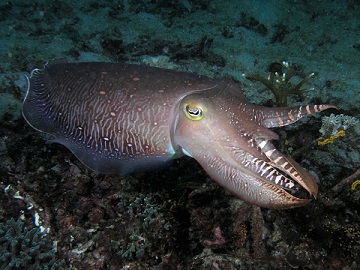SATS-192-cuttlefish- website.jpg

Experiments show that cuttlefish are able to wait longer for better rewards. Credit: Wikimedia Commons, Nick Hobgood / CC-BY-SA-3.0
If you receive a slice of pie but learn you will get a whole pie to yourself if you can wait ten minutes, could you wait? Scientists previously thought only humans and other apes could delay gratification. Then they learned crows and parrots could wait for better rewards too. It turns out cuttlefish, a relative of octopuses and squid, have the same ability to forgo one treat to wait for a more desirable one.
Scientists at the Marine Biological Laboratory in Woods Hole, Massachusetts designed an experiment for cuttlefish based on the famous marshmallow study, in which children could receive one marshmallow right away or wait a bit longer for two. The researchers tested six cuttlefish, one at a time, in an aquarium with two chambers containing prey. The researchers had already trained the cuttlefish to understand how the chambers operated—including delays in opening and that approaching the prey in one chamber made the other chamber inaccessible.
One chamber contained a raw king prawn. Previous tests showed cuttlefish would eat prawn if nothing else was around. The other chamber contained live grass shrimp, a much more appealing item to a cuttlefish. Then the scientists tested whether the cuttlefish would eat the prawn immediately or wait for the chamber with the live grass shrimp to open.
The cuttlefish waited one to two minutes, similar to self-control seen in chimpanzees, crows and parrots. The cuttlefish that could wait the longest also performed best in other mental tasks, showing a link between their ability to delay gratification and cognitive ability. But why did cuttlefish evolve this ability? The researchers suspect it has to do with the need for cuttlefish to camouflage themselves and wait, out of sight from predators, before snatching up a meal. Those who could wait, survived.


